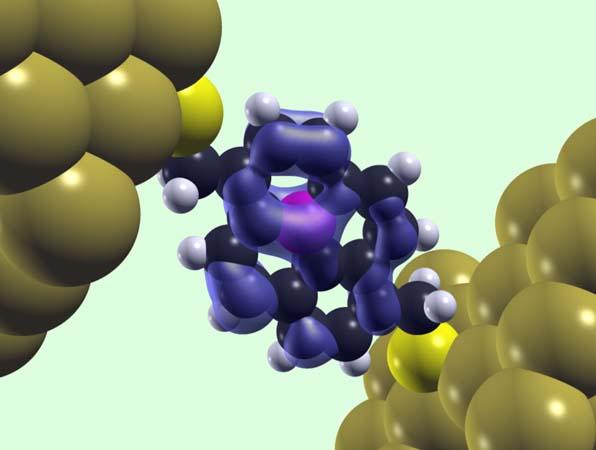An international team of researchers from several research institutes and universities reports an important development in the understanding of the electrical conductivity of single particles.

An international team of researchers from several research institutes and universities reports an important development in the understanding of the electrical conductivity of single particles.
Minimal size, maximum efficiency - the use of diodes as components in electronic circuits shows enormous potential. One of the most important challenges to date is the fact that most mules begin to conduct electricity only after a high voltage has been applied to them. An international research team, with the participation of the University of Graz, showed that alloys containing an unpaired number of electrons conduct much better at low voltages. These important and fundamental findings in the very active research field of nanotechnology open a window to a diverse collection of possible applications: microchips, and other electronic components, which are more efficient and have a much higher storage capacity at hand.
One electron instead of two - most stable molecules have a shell structure filled with an even number of electrons. Ferrods with an odd number of electrons are more difficult to synthetically prepare by chemists, but they conduct electricity better at lower voltages. Although the use of an odd number of electrons instead of an even number seems simple, it is a significant factor in the field of nanotechnology - as a result, it is now possible to replace metallic components of electronic circuits with single parts. "This finding brings us significantly closer to the absolute miniaturization of electronic components," explains Egbert Zojer, a researcher from the Institute of Solid State Physics at the University of Graz.
The motivation for this basic research is the vision of electrical circuits that will consist of only a few parts. "If it is indeed possible to reach a situation where molecular components will fully replace the functions of various circuit components - this will lead to an extensive collection of possible applications, the full capabilities of which will only be revealed over time. In our research, we showed a way to make this possible," says the researcher.
Unique innovative possibilities have now opened up in the fields of molecular electronics, sensing technologies or in the development of biologically adapted interfaces between inorganic and organic materials, including: biological systems such as human cells, which can be connected to electrical circuits in a biologically appropriate manner using conductive separations.

6 תגובות
I actually heard about Hans Christian Orsted (when I studied electricity)
Who was this Hans Christian Oersted who is credited with so much activity in the field of electricity and magnetic phenomena that created breakthroughs in the field of electromagnetic phenomena....
I understand that Hans Christian Oersted was a brilliant chemist and also a very talented physicist from Denmark. I read about him online that he was very much based on the activity and doctrine of Emanuel Kent Hedgo.
But is that Hans Christian Oersted the one who really should be given the primacy as a trailblazer.
I read that the same Hans Orsted (Orsted), who is not so well known and yet is now receiving some kind of praise, did various experiments with electric current, dealt with magnetic fields, then specialized in electricity and acoustics.
I also read that the CGS which is a magnetic induction unit is named after him and the first satellite launched by Denmark into space. It is amazing that the same Hans Christian Oersted is such a central key figure in the field of magnetism and magnetism and yet, despite his name, he is not widely known in the same way that leading geniuses and pioneers who did less do.
Anonymous, I assume you think that a ferrode with an odd number of electrons is necessarily an ion (or a radical) and it will conduct better than a ferrode with an even number of electrons without an electric charge, but there are also ions with an even number, for example SO4 with a charge (2-).
Anonymous, what exactly is trivial here? Do you think you can imagine the forces at work in the deserts? It is extremely complex.
anonymous:
What are you trying to say?
That you are smarter than the one who discovered it?
If this is true, maybe in the future you should publish your conclusions before someone else publishes them.
Everything seems much simpler after they discovered it but:
1. It is a fact that before most people thought that a single conductor would be a poor conductor of electricity
2. The fact is that this conclusion was reached after testing many mares
3. It is a fact that in nature it is very difficult to find a stable particle with an odd number of electrons in the shell
4. And it's also a fact that, after all, someone realized that it's worth trying to test ferrodes that are characterized by an odd number of electrons in the shell. That someone is the research team the article is talking about, not you.
Isn't it trivial that an odd elect number will conduct more easily? This is a question of Tamm and not defiance. On the face of it, there doesn't seem to be any reason to think otherwise.